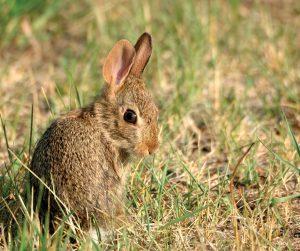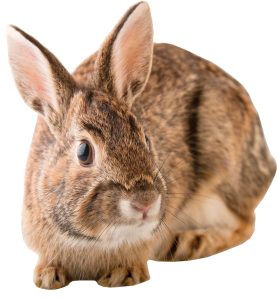 The Eastern cottontail rabbit (Sylvilagus floridanus) is our common bunny and is found throughout the eastern and central United States. Existing in grassy and shrubby areas, cottontail rabbits need to have escape cover to hide from the many other animals that prey upon them. They generally avoid dense woods and are brownish in color to camouflage them against attack. Cottontails can be seen in many parts of Tallahassee that provide suitable habitat. Indianhead Acres, Governor’s Park, and Myers Park are all home to rabbits as well as other small native wildlife.
The Eastern cottontail rabbit (Sylvilagus floridanus) is our common bunny and is found throughout the eastern and central United States. Existing in grassy and shrubby areas, cottontail rabbits need to have escape cover to hide from the many other animals that prey upon them. They generally avoid dense woods and are brownish in color to camouflage them against attack. Cottontails can be seen in many parts of Tallahassee that provide suitable habitat. Indianhead Acres, Governor’s Park, and Myers Park are all home to rabbits as well as other small native wildlife.
Cottontails can live out their lives on a couple of acres of land. Females, known as does, have smaller home ranges. The males, called bucks, travel more widely and will fight other males for dominance. As these rabbits cannot dig their own denning holes, they take advantage of other creatures’ excavations, such as woodchuck holes up North. When no holes are available, they make what are called forms, essentially depressions in the ground that provide some warmth and cover.
Essentially vegetarians, studies show over 100 different plant species are eaten by cottontails. They consume bark and twigs, seeds, flowers, and fruit as available. Even with all this eating, most rabbits do not weigh more than 2.5 pounds.
 Rabbits are renown for having a lot of babies, and it may be temperature that drives mating. In Florida, mating season can last up to nine months, and rabbits do not pair off as parents. Average gestation is a mere 28 days. After only one month, the young are independent of the mother and are able to have their own babies in about three months. In Florida, doe rabbits may have up to seven litters per year. With the average litter size of five, cottontail rabbits can have up to 35 young per year!
Rabbits are renown for having a lot of babies, and it may be temperature that drives mating. In Florida, mating season can last up to nine months, and rabbits do not pair off as parents. Average gestation is a mere 28 days. After only one month, the young are independent of the mother and are able to have their own babies in about three months. In Florida, doe rabbits may have up to seven litters per year. With the average litter size of five, cottontail rabbits can have up to 35 young per year!
Why are we not overflowing with rabbits? That is because mortality is high. Roadkill and predation by larger animals keep the population in check. Predators include foxes, domestic dogs and cats, coyotes, owls, snakes, and hawks. Baby rabbits are also consumed by racoons and opossums.
Our other rabbit, which can be seen at St. Marks National Wildlife Refuge, is the marsh rabbit (Sylvilagus palustris). Living on coasts and in the swamps of the Southern United States, the marsh rabbit resides near water. Somewhat similar in appearance to the Eastern cottontail, this species possesses smaller ears and legs and a smaller tail. Weighing slightly over two pounds at full growth and reaching about 17 inches long, it has dark or brownish-red fur and a lighter colored belly. Unlike cottontails, this rabbit has a brownish grey underside to its tail (not white). Marsh rabbits produce young year-round with females being able to have up to 20 annually. They need a lot of youngsters because many other animals eat them! Strictly herbivores, these little rabbits eat leaves and plant bulbs, including cattails and water hyacinth. Usually active at night, they are excellent swimmers and will hide from predators submerged with only eyes and noses exposed and with their ears laid back.
 In Tallahassee, we are fortunate to share our home with many incredible creatures. These tiny prey animals may be hard to spot as they hide for safety from predators. Whether you are in your own backyard or at one of our beautiful local parks or greenways, keep an eye out for these adorable rabbits.
In Tallahassee, we are fortunate to share our home with many incredible creatures. These tiny prey animals may be hard to spot as they hide for safety from predators. Whether you are in your own backyard or at one of our beautiful local parks or greenways, keep an eye out for these adorable rabbits. ![]()
Preston Robertson
Florida Wildlife Federation
 Want to help Florida’s wildlife? Join Florida Wildlife Federation (FWF), floridawildlifefederation.org, (850) 656-7113. FWF is a Tallahassee-based non-profit organization that has been advocating for wildlife and wild places since 1936.
Want to help Florida’s wildlife? Join Florida Wildlife Federation (FWF), floridawildlifefederation.org, (850) 656-7113. FWF is a Tallahassee-based non-profit organization that has been advocating for wildlife and wild places since 1936.




